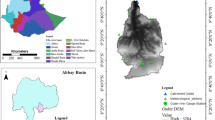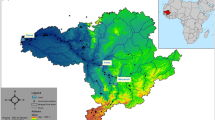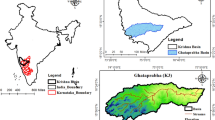Abstract
The study area of the Morava River floodplain is situated between the rivers Morava and Kyjovka in the reach from Hodonín to Lanžhot. This experimental area was chosen because during the last 30 years, there has been a serious problem with the frequent occurrence of hydrological extremes, such as floods and droughts. Dry seasons have a very negative impact on the floodplain forest and have been caused mainly by regulation of the Morava River channel in the 1970s. Since flooding in the catastrophic year 1977, a part of this area has served as a polder for flood impact mitigation of the urbanised area of the town of Lanžhot. Management and farming practices have been heavily affected by the enormous economic and ecological damage due to long-term flooding of agricultural land. The purpose of this study is to assess the extent to which the precipitation in the growing season of the dry years 2003 and 2011 was deficient, in comparison with the normal year 2009, through a study of the actual evapotranspiration caused by the significant drought in the Morava floodplain. A similar but converse situation in the wet year 2010 was also analysed, with the aim to show the differences in the components of the water balance equation in the growing seasons of all the extreme years tested here. The daily data from the Kostice climatological station were processed using the WBCM-7 model, where the input parameters were calibrated by the fluctuation of the groundwater table in the control borehole.








Similar content being viewed by others
References
Abbott, M. B., Bathurst, J. C., Cunge, J. A., O’Connell, P. E., & Rasmussen, J. (1986a). An introduction to the European Hydrologic System—Système Hydrologique Européen, SHE, 1: history and philosophy of a physically based, distributed modelling system. Journal of Hydrology, 87, 45–59.
Abbott, M. B., Bathurst, J. C., Cunge, J. A., O’Connell, P. E., & Rasmussen, J. (1986b). An introduction to the European Hydrologic System—Système Hydrologique Européen, SHE, 2: structure of a physically based, distributed modelling system. Journal of Hydrology, 87, 61–77.
Andrew, R. M., & Dymond, J. R. (2007). A distributed model of the water balance in the Motueka catchment, New Zealand. Environmental Modelling & Software, 22, 1519–1528.
Arnold, J. G., Srinivasan, R., Muttiah, R. S., & Williams, J. R. (1998). Large area hydrologic modeling and assessment part I: model development. Journal of the American Water Resources Association, 34(1), 73–89.
Banks, E. W., Simmons, C. T., Love, A. J., & Shand, P. (2011). Assessing spatial and temporal connectivity between surface water and groundwater in a regional catchment: implications for regional scale water quantity and quality. Journal of Hydrology, 404(1-2), 30–49.
Bergström, S. (1995). The HBV model. In V. P. Singh (Ed.), Computer models of watershed hydrology (pp. 443–520). Highlands Ranch, Colorado, USA: Water Resources Publications.
Beven, K. J., Lamb, R., Quinn, P., Romanowicz, R., & Freer, J. (1995). TOPMODEL. In V. P. Singh (Ed.), Computer models of watershed hydrology (pp. 627–668). Highlands Ranch, Colorado, USA: Water Resources Publications.
Brauman, K. A., Freyberg, D. L., & Daily, G. C. (2012). Potential evapotranspiration from forest and pasture in the tropics: a case study. Journal of Hydrology, 440–441(2012), 52–61.
Brown, A. E., Zhang, L., McMahon, T. A., Western, A. W., & Vertessy, R. A. (2005). A review of paired catchment studies for determining changes in water yield resulting from alterations in vegetation. Journal of Hydrology, 310(1-4), 28–61.
Burnash, R. J. C. (1995). The NWS river forecast system—catchment modelling. In V. P. Singh (Ed.), Computer models of watershed hydrology (pp. 311–366). Highlands Ranch, Colorado, USA: Water Resources Publications.
Dessie, M., Verhoest, N. E. C., Admasu, T., Pauwels, V. R. N., Poesen, J., Adgo, E., Deckers, J., & Nyssen, J. (2014). Effects of the flood plain on river discharges into Lake Tana (Ethiopia). Journal of Hydrology, 519(2014), 699–710.
Gunkel, A., Shadeed, S., Hartmann, A., Wagner, T., & Lange, J. (2015). Model signature and aridity indices enhance the accurancy of water balance estimations in a data-scarse Eastern Mediterranean catchment. Journal of Hydrology: Regional Studies, 4(2015), 487–501.
Hadaš, P. (2004). Water balance of the riparian forest of southern Moravia in the year 2003. In J. Rožnovský & T. Litschman (Eds.), Extrémy počasí a podnebí (pp. 24–25). Brno: The Czech Bioclimatic Society.
Han, E., Merwade, V., & Heathman, G. C. (2012). Implementation of surface soil moisture data assimilation with watershed scale distributed hydrological model. Journal of Hydrology, 416–417, 98–117.
Kirchner, J. W. (2009). Catchment as simple dynamical systems: catchment characterization, rainfall-runoff modelling and doing hydrology backward. Water Resources Research. doi:10.1029/2008/WR006912.
Kovář, P. (2006). The extent of land use impact on water regime. Plant, Soil and Environment, 52(6), 239–244.
Kovář, P., & Vaššová, D. (2010). Impact of arable land to grassland conversion on the vegetation-period water balance of small agricultural catchment (Němčický Stream). Soil and Water Research, 5(4), 128–138.
Kovář, P., Cudlín, P., & Šafář, J. (2004). Simulation of hydrological balance on experimental catchments Všeminka and Dřevnice in the extreme periods 1992 and 1997. Plant, Soil and Environment, 50(11), 478–483.
Krause, P., Boyle, D. P., & Bäse, F. (2005). Comparison of different efficiency criteria for hydrological model assessment. Advances in Geosciences, 5(89–97), 2005.
Kulhavý, Z., & Kovář, P. (2000). Use of water balance models for small catchments. Praha: VÚMOP Praha.
Legates, D. R., & McCabe, G. J., Jr. (1999). Evaluating the use of “goodness of fit” measures in hydrologic and hydroclimatic model validation. Water Resources Research, 35(1), 233–241.
Monteith, J. L. (1965). Evaporation and environment. In G. E. Fogg (Ed.), The state and movement of water in living organisms (pp. 205–234). UK: Academic Press for the Society for Experimental Biology.
Moretti, G., & Montanari, A. (2007). AFFDEF: a spatially distributed grid based rainfall–runoff model for continuous time simulations of river discharge. Environmental Modelling & Software, 22, 823–836.
Motovilov, Y. G., Gottschalk, L., Engeland, K., & Belokurov, A. (1999). ECOMAG: regional model of hydrological cycle. Oslo: University of Oslo.
Nash, J. E., & Sutcliffe, J. V. (1970). River flow forecasting through conceptual models. Part I—a discussion of principles. Journal of Hydrology, 10, 282–290.
NRCS. (1986). Urban Hydrology for Small Watersheds. Technical Release 55 (13). Washington D.C: U.S. Department of Agriculture.
Penman, H. L. (1963). Vegetation and hydrology. Harpenden, U. K: Technical Committee 53, C. Bureau of Soils.
Priestley, C. H. B., & Taylor, R. J. (1972). On the assessment of surface heat flux and evaporation using large-scale parameters. Monthly Weather Review, 100, 81–82.
Refsgaard, J. C., & Storm, B. (2005). MIKE SHE. In V. P. Singh (Ed.), Computer models of watershed hydrology (pp. 809–846). Highlands Ranch, Colorado, USA: Water Resources Publications.
Sánchez, N., Fernández, J. M., Calerab, A., Torres, E., & Gutiérrez, C. P. (2010). Combining remote sensing and in situ soil moisture data for the application and validation of a distributed water balance model (HIDROMORE). Agricultural Water Management, 98, 69–78.
Schmidt S. (2014). Hydrogeological characterisation of karst aquifer in semi-arid environments at the catchment scale-example of the Western Lower Jordan Valley. In: PhD. Thesis. University of Göttingen, Germany.
Smiatek, G., Kunstmann, H., & Heckl, A. (2014). High-resolution climate change impact analysis on expected future water availability in the Upper Jordan catchment and the Middle East. J. Hydrometeor., 15, 1517–1531.
Soukalová, E. (2012). Groundwater regimes in the confluence of the Morava and Thaya rivers. Brno: ČHMÚ Brno.
Turc, L. (1961). Evaluation des besoins en eau d’irrigation, evapotranspiration potentielle. Annales agronomiques, 12, 13–49.
Vázquez-Suñé, E., Sánchez-Vila, X., & Carrera, J. (2005). Introductory review of specific factors influencing urban groundwater, an emerging branch of hydrogeology, with reference to Barcelona, Spain. Hydrogeology Journal, 13(3), 522–533.
Zhou, M. C., Ishidaira, H., Hapuarachchi, H. P., Magome, J., Kiem, A. S., & Takeuchi, K. (2006). Estimating potential evapotranspiration using Shuttleworth-Wallace model and NOAA-AVHRR NDVI data to feed distributed hydrological model over the Mekong River basin. Journal of Hydrology, 327(1-2), 151–173.
Acknowledgments
Field studies, model improvement, assessment and evaluation have been supported by a grant from the Ministry of Agriculture, the Czech Republic, Project NAZV, QJ 1220033 ‘Optimization of water regime on the Morava river floodplain’.
Author information
Authors and Affiliations
Corresponding author
Appendix 1
Appendix 1
The explanation of the symbols to Fig. 3 and Fig. 4:
Fig. 3:
RUL (J) = THR (J) − OF (J) − PES (J) (mm)
RUL (J): Positive (filling) or negative (exhausting) functions (mm)
THR (J): Throughfall, OF (J): overlandflow, PES (J): potential soil evaporation
FCUL: Field capacity of upper layer (incl. root zone, in mm)
SMDU (J) = FCUL − WUL (J): Soil moisture deficit (mm)
ΔWUL = WUL (J) − WUL (J-1): Soil moisture content in 1 day (mm)
AES (J): Actual soil evaporation (mm)
J: The day index (−)
Fig. 4:
Resulting equations:
GWS (J) = GWS (J-1) + GWR (J) × (1.0 − (GWS (J-1)) / GWM
GWR (J) = (RECH (J) − AES (J)) × (1.0 − FCLL (J-1) − WLL (J-1)) / FCLL (J-1)
GWF (J) = (GWR (J) × (GWS (J-1) / GWM)
GWT (J) = GWT (J-1) − ((GWS (J) − ((GWS (J) − GWS (J-1)) / POR) / 10.0
BF (J) = BF (J-1) × exp (−1.0 / BK) + GWF (J) × (1.0 − exp (−1.0 / BK))
GWS (J): Groundwater storage (mm)
GWR (J): Groundwater recharge (mm)
RECH (J): Infiltration recharge (from the CN method, in mm)
GWF (J): Groundwater flow (mm)
GWT (J): Groundwater table (m above sea level (m a.s.l.))
GWM: Maximum capacity of active groundwater zone (mm)
FCLL (J): Field capacity of lower layer
BF (J): Baseflow (transformed from groundwater flow, in mm)
WCR (J): Water capillary rise (if groundwater is shallow, in mm)
Rights and permissions
About this article
Cite this article
Kovář, P., Heřmanovská, D., Hadaš, P. et al. Water balance analysis of the Morava River floodplain in the Kostice-Lanžhot transect using the WBCM-7 model. Environ Monit Assess 188, 74 (2016). https://doi.org/10.1007/s10661-015-5080-7
Received:
Accepted:
Published:
DOI: https://doi.org/10.1007/s10661-015-5080-7




